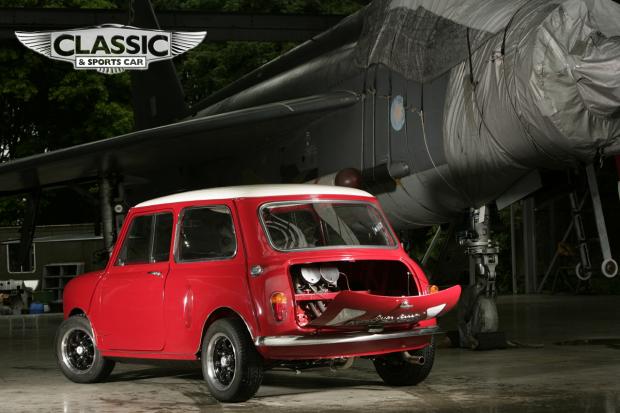The Cooper Twini never raced, but Sir John Whitmore did test it extensively at Brands Hatch and got down to a 67-second best on special 4½in magnesium wheels. On narrower rims he later pushed too hard and spun off. “The Twini was very neutral when both engines were in tune,” reported Whitmore, “but if one played up the handling changed dramatically.” At Goodwood, when the front motor failed, he lapped with just rear power. Although the racing knight’s times were 2 secs faster than the Mini record, on the limit the Twini oversteered like a pig.

The Cooper-built Twini came to a dramatic end on the Kingston bypass in May 1964. The huge accident not only destroyed the car, but also left John Cooper fighting for his life. En route to Roy Salvadori’s new Esher home for a dinner party, the Twini rolled several times and Cooper woke up in hospital with cracked ribs, amnesia and severe concussion. The timing was particularly bad because his father was frail with heart problems and control of the racing team seemed to be ebbing away. The wreck was so bad it was difficult to ascertain what had caused the smash. One theory reported that the front engine had cut out, or possibly a gearbox jammed, causing a sudden change in handling. “We think the balljoint in one of the steering arms seized,” said Cooper. “It was a freak accident, but the publicity killed the Twini stone dead and BMC did the same. It was a pity; the idea had enormous potential, particularly in rallying. It was years before the Audi quattro.”

In parallel with Cooper’s project, engine tuning specialist Downton Engineering also produced a Twini that it boldly entered alongside a standard car in the 1963 Targa Florio. Fitted with two 998cc Riley Elf engines, the car was only just finished before the team left for Italy and had barely been tested. Braking was by Cooper ‘S’ discs all round and the transmissions had straight-cut competition gears. The suspension was lowered by 1in and the fuel tanks carried six gallons. Whitmore was teamed with Le Mans winner Paul Frère, who came out of retirement for the classic Sicilian road race. The large air scoop just ahead of the right rear wheel channeled air to the engine, but the Mediterranean heat took its toll on the ‘prototipo buffa’ (funny prototype), which ran in the under-2-litre GT class. ‘It was great fun and greatly admired for its audaciousness,’ wrote ‘Jenks’ in Motor Sport.

The Targa Twini was plagued with problems and forced to stop several times on the course during the early laps to refill the radiator. In addition to the overheating, the tortuous mountain circuit caused transmission problems and the paired linkage often failed to synchronise gearchanges, resulting in the two engines turning at different speeds. Frère proved the more cautious of the team, setting slower times in an attempt to conserve coolant and tyres, while Whitmore was a crowd favourite, blasting the Twini over the start/finish line in a full-blooded powerslide to cheers of “avanti” from the locals. “We’ll have some fun,” Whitmore informed Jenks, “even if it doesn’t last the race.”

Thankfully for the Downton pit crew, the weather later cooled and the regular stops for water abated. Both Minis made the finish, albeit two laps down on the winning Porsche, with the standard car of Bernard Cahier and Rob Slotemaker 25th, two places ahead of the Twini. No doubt they had a happier post-race party than Ferrari, which lost the lead on the last lap.

How many Twini Minis were built is a mystery. If you include the Moke and Emery’s effort it was four, but contemporary reports record BMC also building a saloon. Sadly, only the Moke survives. Roll on four decades and Jeff Lane, collector of weird and wonderful motors for his Nashville museum, started thinking about a Twini to join his 2CV Sahara. His search for a survivor proved fruitless, so the only option was to recreate one. Through his passion for microcars, Lane met British Peel enthusiast Andy Carter at the marque’s 50th anniversary return to the Isle of Man. Carter then sourced a rare Mini-based Peel Viking and restored it for Lane. “Jeff was pleased with the car, which led to enquires about the Twini,” says Carter. “No one seemed to know what happened to them, other than that the Cooper car was destroyed in 1963. My hasty suggestion that we could easily build one was immeidiately taken up by Jeff.”

Two donor Mk1 shells were sourced, and work started in August 2007. By chance, Carter’s son Rory owned a Mk1 but he refused to let dad cut it up. “Our key reference was a cutaway drawing and detail photographs published in an American magazine,” says Andy. “Without that we would really have struggled on the cockpit details. We decided to go for 1275cc power units with identical tune at both ends. It was important that the gearboxes had the same final drive, too. Like Cooper, we chose rubber-cone suspension with disc brakes all round. The beautiful simplicity of the Mini made the job easy. Although the project was built for show, it had to work.












